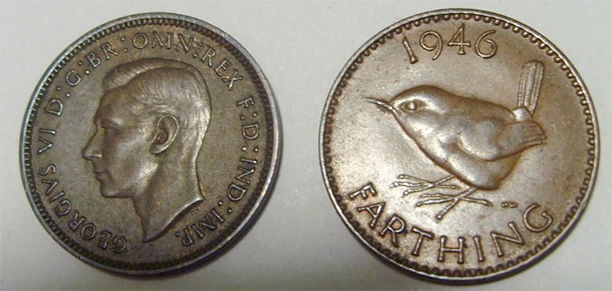The Farthing's Last Day
The farthing ceased to be legal tender on December 31st, 1960.
 The stroke of midnight that ushered in New Year’s Day 1961 tolled the funeral bell for the farthing. Originally a fourthling, or fourth part of a penny, Britain’s tiniest coin had a history stretching back to the 13th century. Until then people would cut a penny into two or four pieces to obtain a smaller coin. The first farthing coins seem to have been tried out as an experiment from around 1216 in the early days of Henry III. A quarter the size of a penny, they were made of silver and showed the young king holding a sceptre, with a cross on the reverse. They evidently met a need as millions of them were issued during the reign of Edward I. They were minted in London and various provincial cities. In the 15th century some were struck in Calais and later third-farthings, worth a 12th of a penny, were minted for use only in Malta.
The stroke of midnight that ushered in New Year’s Day 1961 tolled the funeral bell for the farthing. Originally a fourthling, or fourth part of a penny, Britain’s tiniest coin had a history stretching back to the 13th century. Until then people would cut a penny into two or four pieces to obtain a smaller coin. The first farthing coins seem to have been tried out as an experiment from around 1216 in the early days of Henry III. A quarter the size of a penny, they were made of silver and showed the young king holding a sceptre, with a cross on the reverse. They evidently met a need as millions of them were issued during the reign of Edward I. They were minted in London and various provincial cities. In the 15th century some were struck in Calais and later third-farthings, worth a 12th of a penny, were minted for use only in Malta.
Coins have always had an important public relations function and James I, who introduced copper farthings, made sure that they bore his title as the ruler of the new entity of Great Britain: Iaco DG Mag Brit (James by the Grace of God King of Great Britain); on the reverse they had a crowned harp and said Fra Et Hib Rex (King of France and Ireland). They were not struck at the Royal Mint in the Tower of London. The contract for producing them went to Lord Harington, a royal favourite who was in charge of the king’s young daughter, Elizabeth. Popularly known as Haringtons, they had a tin surface that made them look more like the earlier silver farthings and also made them harder to fake. Later on, when the tin was dropped, fake farthings multiplied and to stop this the new Rose farthing was introduced in the 1630s, made partly of brass with a rose on the back.
New farthings and halfpennies were introduced in Charles II’s time in 1672, with a figure of Britannia on the reverse. The model for Britannia was Frances Stewart, the beautiful Duchess of Richmond. In 1936 she was replaced on the reverse of the coin by the wren, Britain’s smallest bird, which remained there to the end.
By the 1950s bus conductors were refusing to accept farthing coins and their value was so small that their usefulness was felt to be over. None were minted after 1956 and they were not legal tender after 1960. The new penny introduced in 1971 is about the same size as a farthing (20 millimetres in diameter), but such has been the fall in the value of money that its purchasing power is less than 50 per cent of what the farthing’s was on its final day.